| Culcita | |
|---|---|
 | |
| Culcita novaeguineae | |
| Scientific classification | |
| Kingdom: | |
| Phylum: | |
| Class: | |
| Order: | |
| Family: | |
| Genus: | Culcita (Agassiz, 1836) |
Culcita is a genus of cushion stars. They are found in tropical waters. Some are kept in home aquariums.
| Culcita | |
|---|---|
 | |
| Culcita novaeguineae | |
| Scientific classification | |
| Kingdom: | |
| Phylum: | |
| Class: | |
| Order: | |
| Family: | |
| Genus: | Culcita (Agassiz, 1836) |
Culcita is a genus of cushion stars. They are found in tropical waters. Some are kept in home aquariums.
These are very particular stars, plump and pillow-shaped, more or less pentagonal. Their five arms have waned to only obtuse angles (and sometimes rounded off or truncated). They can measure up to 30 cm in diameter, and are typical of Indo-Pacific coral reefs, where they feed on benthic invertebrates and coral.
Two species Culcita novaeguineae and Culcita schmideliana are extremely similar and almost impossible to differentiate by sight, except that C. schmideliana has larger tubercles, that are normally absent from papular areas [1] (though both species can also be naked). They are thus distinguished mostly by their area of distribution: C. schmideliana lives in the Indian Ocean (from Africa to the Maldives), and C. novaeguineae in Oceania and the Pacific Ocean. The third species, C. coriacea, lives in the Red Sea and around Arabia, and is slightly different in appearance.
This genus is not to be confused with similar cushion-shaped species such as Halityle regularis . [2]
The juveniles are flat and pentagonal, and can look like "biscuit sea stars" from the family Goniasteridae (such as Peltaster spp.). [3]
The genus contains three species: [4]

Starfish or sea stars are star-shaped echinoderms belonging to the class Asteroidea. Common usage frequently finds these names being also applied to ophiuroids, which are correctly referred to as brittle stars or basket stars. Starfish are also known as asteroids due to being in the class Asteroidea. About 1,900 species of starfish live on the seabed in all the world's oceans, from warm, tropical zones to frigid, polar regions. They are found from the intertidal zone down to abyssal depths, at 6,000 m (20,000 ft) below the surface.

Astropecten polyacanthus, the sand sifting starfish or comb sea star, is a sea star of the family Astropectinidae. It is the most widespread species in the genus Astropecten, found throughout the Indo-Pacific region. The armspread is up to 20 cm (8 in). The specific epithet "polyacanthus" comes from the Latin meaning "many thorned".

Culcita novaeguineae is a species of starfish. It has short arms and an inflated appearance and resembles a pentagonal pincushion. It is variable in colour and can be found in tropical warm waters in the Indo-Pacific.

Culcita schmideliana, commonly known as the spiny cushion star, is a species of pin-cushion star. It has a variety of base colors and often patches of a different color. It is pentagonal in shape and lives in the tropical Indo-Pacific. This species is rarely kept by hobby aquarists.
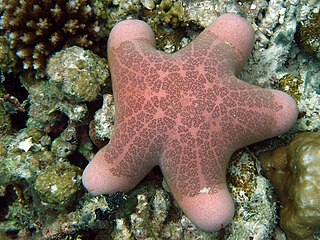
The Oreasteridae are a family of sea stars in the class Asteroidea.

Astrosarkus idipi is a species of sea stars in the family Oreasteridae. It is the sole species in the genus Astrosarkus. It is sometimes referred to as a "Pumpkin sea star".

Culcita coriacea, commonly known as the Arabian cushion star, is a species of pin-cushion star.
The star pearlfish, Carapus mourlani, is a species of slender, ray-finned fish in the family Carapidae. It normally lives inside a starfish or a sea cucumber.

Gersemia rubiformis, commonly known as the sea strawberry, is a species of soft coral in the family Nephtheidae. It is found in the northwest Atlantic and the northeast Pacific Oceans.
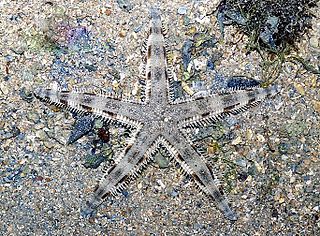
Archasteridae is a family of starfish found in shallow waters in the tropical Indo-Pacific region. The genus Astropus, previously included in this family, is now included in the genus Archaster with the single species, Astropus longipes, being accepted as Archaster lorioli Sukarno & Jangoux, 1977.

Archaster typicus is a species of starfish in the family Archasteridae. It is commonly known as the sand star or the sand sifting star but these names are also applied to starfish in the genus Astropecten. It is found in shallow waters in the Indo-Pacific region.

Hippasteria is one of 70 genera of sea star in the diverse family Goniasteridae.

Fromia is a genus of starfish belonging to the family Goniasteridae.

Trapezia rufopunctata is a species of guard crabs in the family Trapeziidae.
Iconaster longimanus, the icon star or double star, is a species of starfish in the family Goniasteridae. It is found in the west and central Indo-Pacific Ocean. The genus name comes from the Greek eikon, meaning portrait or image and possibly referring to the way the marginal plates frame the disc, and aster, meaning star. The specific name comes from the Latin longus manus and refers to the long, slender arms.
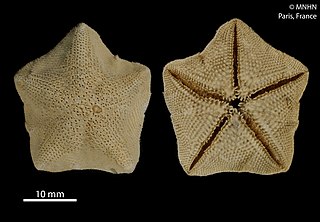
Cryptasterina pentagona is a species of starfish in the family Asterinidae. It is found in shallow waters in north eastern Australia. Its life cycle includes the release of large-yolked eggs and the development of planktonic larvae which is in contrast to the very similar Cryptasterina hystera which is viviparous. The two appear to have diverged from a common ancestral line only a few thousand years ago.
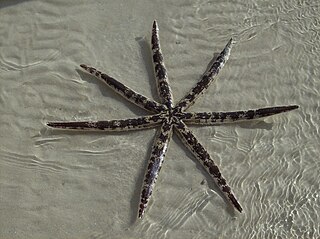
Luidia maculata is a species of starfish in the family Luidiidae in the order Paxillosida. It is native to the Indo-Pacific region. It is commonly known as the eight-armed sea star because, although the number of arms varies from five to nine, eight arms seems to be the most common.
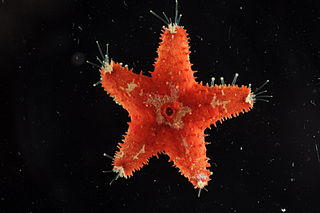
Euretaster insignis, commonly known as the striking sea star, is a species of starfish in the family Pterasteridae found in the central west Pacific Ocean. It is one of only three species in the order Velatida to be found in shallow water in the tropics. The young are brooded in a cavity underneath a "supradorsal" membrane.

Periclimenes, commonly known as glass shrimp or cleaner shrimp, is a commensal and often symbiotic genus of semi-transparent shrimp within the family Palaemonidae. Species of this large genus feature a wide variety of coloration and patterns, widespread distribution throughout much of the world's tropical oceans, and are often sought out for aquarium trade.